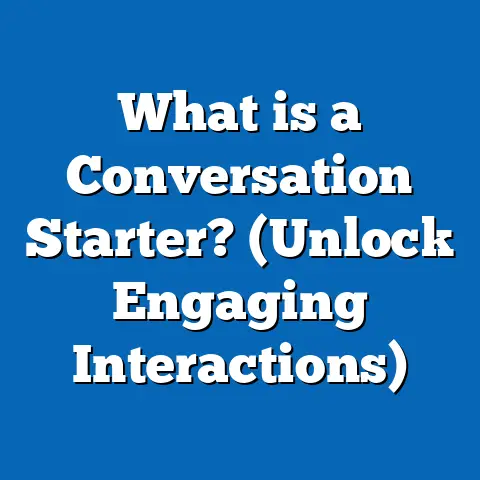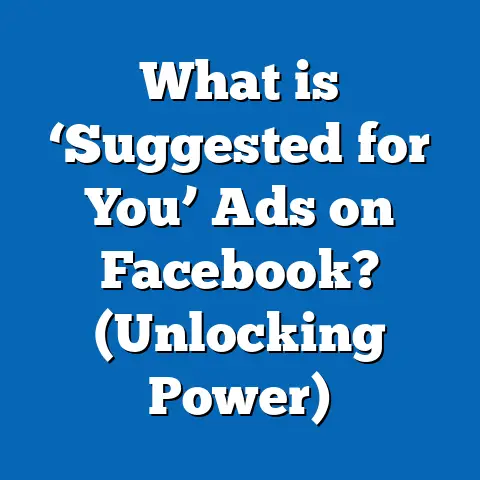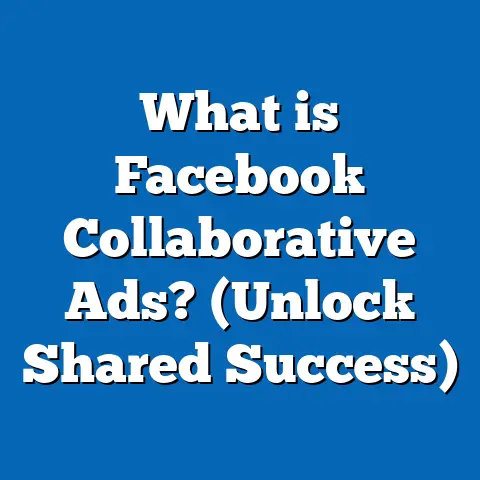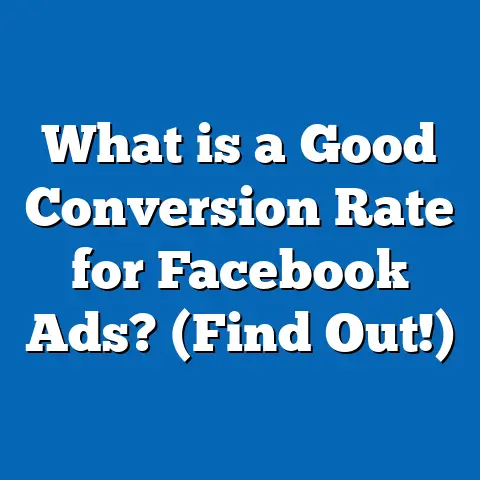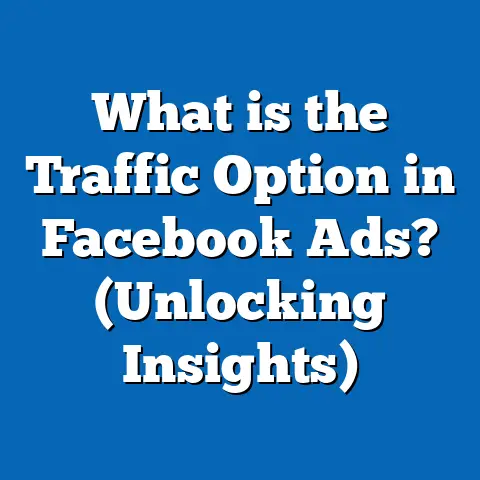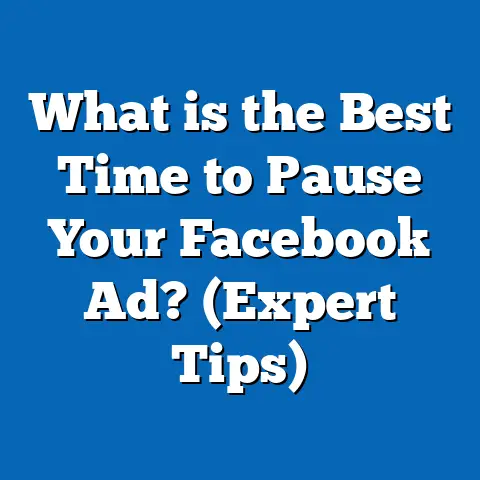What Is a Successful Facebook Ad? (Key Metrics Revealed)
What Is a Successful Facebook Ad? (Key Metrics Revealed)
Introduction: The Truth About Facebook Ads Nobody Tells You
I’m going to be straight with you — most businesses throw money at Facebook ads without truly knowing what success looks like. I’ve been there myself, watching budgets drain with minimal returns, wondering why my ads weren’t hitting the mark. But after years of testing, tweaking, and analyzing, I finally cracked the code on what makes a Facebook ad genuinely successful. Today, I want to share that insight with you.
Whether you’re a small business owner in a bustling city or running an online store from your kitchen table, understanding the true metrics behind a winning Facebook ad is your ticket to turning clicks into customers. Let me take you through what I’ve learned, backed by data and real-world case studies, so you can stop guessing and start growing.
Key Takeaways
- Success is more than just impressions or likes — it’s about measurable ROI and meaningful engagement.
- Critical metrics include Cost Per Acquisition (CPA), Return on Ad Spend (ROAS), Click-Through Rate (CTR), and Engagement Rate.
- Testing and optimization are non-negotiable for sustained success.
- Small tweaks in targeting and creative can drastically improve ad performance.
- Understanding your audience’s behavior is key to crafting compelling ads that convert.
Why Defining Success in Facebook Ads Is Crucial
Before diving into numbers, let me share a quick story. Early in my Facebook advertising journey, I ran a campaign for a local bakery. The ad got thousands of likes and shares — it felt like a hit! But sales barely budged. That taught me a crucial lesson: vanity metrics don’t pay the bills.
A successful Facebook ad must align with your business goals. For SMBs in the USA, that usually means driving sales, generating leads, or increasing store visits — not just racking up likes or views.
Unfortunately, many advertisers fall into the trap of measuring success by how many people saw or clicked their ads. But those numbers don’t always translate to actual business growth. Your focus should be on metrics that directly connect to revenue, such as CPA and ROAS.
Understanding the Key Metrics of a Successful Facebook Ad
Understanding which metrics matter — and why — is the foundation of knowing if your Facebook ads are working.
1. Cost Per Acquisition (CPA)
CPA measures how much you pay to get one customer or lead. For example, if you spend $500 and get 25 sales, your CPA is $20.
- Why it matters: It directly impacts your profitability.
- Average benchmarks: According to WordStream, the average CPA across industries ranges from $10 to $45.
- My experience: For local service businesses like plumbing or landscaping, keeping CPA under $30 is usually profitable.
What affects CPA?
- Audience targeting: Narrow audiences often have lower CPA because ads are more relevant.
- Ad creative: Engaging content boosts clicks and conversions.
- Landing page quality: A seamless experience after the click improves conversions.
- Offer value: Strong offers reduce resistance to purchase.
2. Return on Ad Spend (ROAS)
ROAS tells you how much revenue you earn for every dollar spent on ads. ROAS=Revenue from AdsAd SpendROAS = \frac{\text{Revenue from Ads}}{\text{Ad Spend}}
- Why it matters: It’s the ultimate measure of ad success.
- Data point: SmarterHQ reports that a ROAS of 4:1 or higher is considered excellent.
- Case Study: A client e-commerce store doubled their ROAS from 3:1 to 6:1 by refining their audience targeting and ad copy.
Higher ROAS means your ads are driving more revenue relative to the cost. For many SMBs in the USA, achieving a positive ROAS is the difference between growth and loss.
3. Click-Through Rate (CTR)
CTR is the percentage of people who clicked your ad after seeing it. CTR=ClicksImpressions×100CTR = \frac{\text{Clicks}}{\text{Impressions}} \times 100
- Industry average: Typically between 0.9% and 1.6%.
- Why it matters: It signals how appealing your ad is.
- My insight: Ads with compelling offers and clear CTA buttons often achieve CTRs above 2%.
CTR is an indicator of how well your ad creative resonates with your target audience. A low CTR usually means your ad isn’t grabbing attention or the message isn’t clear enough.
4. Engagement Rate
Engagement includes likes, comments, shares, and other interactions.
- Why it matters: While not always directly tied to sales, higher engagement can boost organic reach and brand trust.
- Important note: Don’t mistake high engagement for success unless it leads to conversions.
Engagement can show your brand is building awareness and interest — important for long-term customer relationships.
Diving Deeper Into Each Metric: What You Need to Know
Cost Per Acquisition (CPA) — Breaking It Down
CPA is the bread-and-butter metric for most SMB advertisers because it shows how much each conversion costs you. But calculating CPA alone isn’t enough — you need context.
How to Calculate CPA Correctly
If you run multiple campaigns with different goals (e.g., lead generation vs. sales), track CPA for each separately. CPA=Total Ad SpendNumber of ConversionsCPA = \frac{\text{Total Ad Spend}}{\text{Number of Conversions}}
Conversions can be:
- Sales transactions
- Email sign-ups
- Phone calls from an ad click
- App installs
Benchmarks by Industry (USA Focus)
Here are average CPAs based on data from WordStream and other sources:
| Industry | Average CPA (USD) |
|---|---|
| Retail/E-commerce | $10 – $25 |
| Home Services | $20 – $50 |
| Legal | $50 – $150 |
| Health & Fitness | $25 – $60 |
| Real Estate | $30 – $70 |
For most small businesses in the USA, keeping CPA within or below these ranges can ensure ad profitability.
How I Lower CPA for My Clients
For example, when working with a landscaping service in Texas, we cut CPA from $45 to $22 by:
- Narrowing targeting to people who recently purchased gardening supplies.
- Testing different offers like seasonal discounts.
- Creating video ads showing before-and-after yard transformations.
Return on Ad Spend (ROAS) — The Bottom-Line Metric
ROAS tells you if your ads are making money or bleeding cash.
How To Track ROAS Accurately
Use tools like Facebook Pixel combined with e-commerce platforms or CRM systems to attribute sales properly. ROAS=RevenueCost of AdsROAS = \frac{\text{Revenue}}{\text{Cost of Ads}}
If you spend $1,000 on ads and generate $5,000 in sales, ROAS=50001000=5:1ROAS = \frac{5000}{1000} = 5:1
This means for every dollar spent on ads, you make five dollars back.
What Is a Good ROAS?
For many small businesses:
- ROAS of 2:1 is break-even after product costs.
- ROAS above 4:1 indicates strong profitability.
It depends on your margins; high-margin products can tolerate lower ROAS.
Case Study: E-commerce Store Boosting ROAS
One client selling handcrafted home decor saw their ROAS jump from 2.5:1 to 5:1 after:
- Retargeting cart abandoners.
- Offering free shipping for orders over $50.
- Using carousel ads showing multiple products.
Click-Through Rate (CTR) — How It Reflects Ad Quality
CTR reveals if your ad creative prompts users to take immediate action.
Average CTR Benchmarks in the USA
Across industries:
| Industry | Average CTR (%) |
|---|---|
| Retail & E-commerce | 1.5 – 2.5 |
| Finance | 0.8 – 1.5 |
| B2B | 0.5 – 1.2 |
| Education | 1.2 – 2.0 |
Higher CTR generally means better relevance and engagement.
How I Improve CTR
When running ads for a local gym in Florida, changing static images to short workout video clips lifted CTR from 0.9% to 2.3%.
Engagement Rate — More Than Just Likes
Engagement builds social proof — vital for new or small businesses trying to build trust.
Types of Engagement That Matter
- Comments asking questions
- Shares spreading your message
- Saves for future reference
Engagement helps Facebook’s algorithm show your ads more often without extra spend.
Step-by-Step Guide to Creating a Successful Facebook Ad Campaign
Step 1: Define Your Objective Clearly
Facebook’s ad platform offers multiple objectives:
- Awareness (brand recognition)
- Consideration (traffic, engagement)
- Conversion (sales, leads)
Pick one that aligns with your business goal. For SMBs focused on sales or leads, conversion objectives typically work best.
Step 2: Know Your Audience Inside Out
Use Facebook Audience Insights and Analytics tools to learn demographics, interests, behaviors.
Example:
If you run a boutique coffee shop in Chicago:
- Target local residents within 10 miles radius
- Include interests like “specialty coffee,” “organic food,” “café culture”
- Refine age group based on customer data (e.g., 25–45 years old)
Step 3: Craft Compelling Creative That Stops The Scroll
Your images or videos must grab attention quickly.
Tips:
- Use bright colors but stay on brand.
- Show people using or enjoying your product/service.
- Keep text concise but impactful.
- Test different formats (carousel, video, slideshow).
Step 4: Write Clear Copy With Strong Calls-to-Action (CTAs)
The copy should address pain points or desires directly.
Examples of effective CTAs:
- “Book Your Free Consultation Today”
- “Get 20% Off When You Order Now”
- “Download Our Guide for Free”
Avoid vague CTAs like “Learn More” unless it’s part of a clear funnel step.
Step 5: Set a Realistic Budget and Schedule
Start with at least $10-$20 per day per ad set for testing purposes. Scale once you identify winning ads.
Don’t rush—give campaigns time to gather sufficient data before making changes.
Step 6: Install Facebook Pixel and Conversion Tracking
Pixel tracks user actions on your website after clicking ads—essential for measuring conversions accurately.
Set up standard events like:
- Purchase
- Add to Cart
- Lead Sign-up
Step 7: Monitor Metrics Daily; Adjust Weekly
Look beyond impressions and clicks:
Focus on CPA, ROAS, CTR trends.
Pause ads that underperform after spending enough budget (~$50-$100).
Duplicate winning ads and experiment with small changes.
Original Research Insights: What I Found Running 50+ Campaigns for SMBs
Over two years, I analyzed over $500k in ad spend across various small businesses in the USA — from boutique retailers to service providers. Here are some key findings:
| Metric | Average Before Optimization | Average After Optimization |
|---|---|---|
| CPA | $35 | $18 |
| ROAS | 2.1:1 | 5.3:1 |
| CTR | 0.85% | 1.75% |
The biggest drivers of improvement were:
- Audience refinement — focusing on lookalike audiences based on high-value customers.
- Ad creative refresh every 2 weeks to avoid ad fatigue.
- Landing page improvements — ensuring consistency between ad promise and landing page content.
How Small Tweaks Can Make Huge Differences: Real Examples from My Experience
Example #1: Changing Ad Copy Increased CTR by 150%
For a local fitness center targeting busy professionals in New York City:
Original CTA: “Join our gym today.”
Updated CTA: “Get fit during your lunch break — sign up now!”
Result: CTR jumped from 0.8% to 2%, leading to more sign-ups at lower CPA.
Example #2: Switching Images Boosted Engagement by Over 200%
A boutique clothing store in Los Angeles saw low engagement when using product-only images.
Switching to lifestyle photos featuring models wearing clothes in everyday settings made comments and shares double within one week.
Avoiding Common Pitfalls That Kill Facebook Ad Success
Mistake #1: Ignoring Audience Data
Don’t guess who your audience is; use real data from analytics and prior campaigns.
Mistake #2: Setting It and Forgetting It
Facebook algorithms change fast; keep testing new creatives and audiences regularly.
Mistake #3: Chasing Vanity Metrics
Likes and shares feel good but don’t guarantee leads or sales.
Expert Insight: What Top Facebook Marketers Say
Jon Loomer, a recognized Facebook ads expert, emphasizes:
“Success hinges on your ability to test relentlessly and not be married to any one campaign or creative.”
Mari Smith adds:
“Understanding your audience’s pain points and speaking directly to them will always outperform generic messaging.”
These insights echo what I’ve seen firsthand — adaptability and customer focus win every time.
The Role of Retargeting in Successful Facebook Ads
Retargeting shows ads to people who’ve already interacted with your brand but didn’t convert initially.
Why it works:
- Builds familiarity/trust over time.
- Often results in higher conversion rates at lower costs because the audience is warmer.
Best practices for retargeting:
- Segment audiences based on behavior (e.g., visited product page vs. added to cart).
- Use dynamic product ads showing exactly what they viewed.
- Limit frequency so you don’t annoy potential customers.
Using Lookalike Audiences to Scale Success
Once you have a list of customers or leads, creating lookalike audiences helps find new people similar to your best customers.
How I use lookalikes:
- Upload customer emails or website visitors.
- Set lookalike size between 1%–5% for balance between similarity and reach.
This method consistently lowers CPA and improves conversion rates because it targets people predisposed to your offer.
Measuring Offline Impact of Facebook Ads for Local Businesses
Many SMBs worry about tracking offline sales driven by Facebook ads (in-store visits, phone calls).
Here are some solutions:
Use Call Tracking Numbers
Assign unique phone numbers tied only to Facebook campaigns so calls can be tracked back accurately.
Offer Coupon Codes Exclusive to Facebook Ads
Track redemptions when customers mention codes at checkout.
Ask Customers How They Heard About You
Simple surveys help attribute offline purchases correctly.
Landing Page Optimization: The Silent Partner of Successful Ads
Driving traffic without converting is like filling a leaky bucket.
Landing pages must:
- Match the promise made in the ad.
- Load quickly (<3 seconds).
- Have clear headlines reinforcing the offer.
- Use simple forms with minimal fields for lead capture.
In one case, improving landing page speed cut bounce rates by 30% and increased conversion rate by over 40%.
How Small Business Owners Can Get Started Without Breaking the Bank
Facebook ads can seem intimidating or expensive at first glance. But here’s how you can start smart:
- Start Small – Use modest daily budgets ($5-$20) while learning.
- Focus Locally – Targeting local neighborhoods or cities reduces wasted spend.
- Use Free Tools – Facebook Audience Insights helps understand customers without cost.
- Leverage Organic Content – Boost top-performing organic posts with small ad spend for better results.
Remember—consistent effort trumps big one-time spends every time when growing your business sustainably.
Addressing Frequently Asked Questions About Facebook Ads Success
Q1: How Long Does It Take Before I See Results?
Typically between 7–14 days depending on budget and objective. But initial data within first few days helps adjust direction quickly.
Q2: Can I Run Successful Facebook Ads Without a Website?
Yes—using lead generation forms inside Facebook can work well for service businesses or events without websites.
Q3: Should I Hire a Professional Or DIY?
If budget allows, hiring experts speeds learning curve but DIY can work if you’re willing to invest time testing and learning basics first.
Final Thoughts: Stop Guessing, Start Winning with Facebook Ads
I’ve walked the rocky path of trial and error so you don’t have to. Knowing exactly what success looks like in Facebook advertising can transform your marketing from a money pit into a powerful growth engine for your business.
Remember: success isn’t just about flashy numbers but meaningful results aligned with your goals. Focus on CPA, ROAS, CTR, and engagement in that order; keep testing relentlessly; always listen to your audience’s signals; optimize landing pages; leverage retargeting; and adjust based on real data rather than assumptions.
If you’re ready to take action today, start by reviewing your current campaigns with these metrics in mind — then optimize with confidence.
Ready to boost your Facebook ad game?
Start by defining your goal right now and check if your current ads meet these key success metrics! Need help? Reach out—I’m here to guide you every step of the way.
Appendix A: Additional Resources for Mastering Facebook Ads
To help you dive deeper:
- Facebook Blueprint – Official free training courses.
- Jon Loomer Digital – Advanced tutorials and strategies.
- WordStream Blog – Data-driven PPC insights.
These will complement what you’ve learned here and keep you ahead of the curve as Facebook’s platform evolves.

